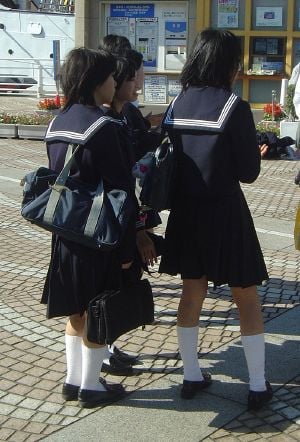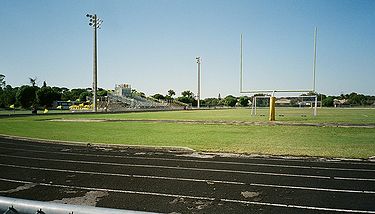High school
| Schools |
|---|
| Education |
| History of education |
| Pedagogy |
| Teaching |
| Homeschooling |
| Preschool education |
| Child care center |
| Kindergarten |
| Primary education |
| Elementary school |
| Secondary education |
| Middle school |
| Comprehensive school |
| Grammar school |
| Gymnasium |
| High school |
| Preparatory school |
| Public school |
| Tertiary education |
| College |
| Community college |
| Liberal arts college |
| University |
A high school is the name used in some parts of the world, particularly in North America, to describe an institution which provides all or part of secondary education. The precise stage of schooling provided by a high school differs from country to country, and may vary within the same jurisdiction. Though they may go by different names, most countries around the world have schools that are similar in philosophy to high schools. In most parts of the world it is the last stage of compulsory schooling, and can prepare a student to continue on to Higher education, such as a college, university, or vocational schooling.
Purpose
High schools and all other similar institutions provide the final stages of secondary education. In some countries, they provide the last stages of compulsory education while in others they are advancements for students who plan to attend tertiary education. Either way, these schools have two significant purposes. First, they are designed to meet the educational expectations set by the state or government, which usually includes a fundamental understanding of mathematics, basic sciences, language skills, geography, government, and history. Secondly, these institutions are charged with preparing students for life after high school, which means either providing technical/vocational skills so that students can enter the workforce, or preparing students for advanced study in college.
History
Before public high schools were first developed in the United States, secondary education in Europe and the West was limited to private tutors and institutions whose main goal was to prepare its students for entrance into a university. By the late nineteenth century the U. S. was the first country to have free, public high schools.[1] The public high school movement, which started in the Massachusetts, was established as a way to satisfactorily educate and prepare for college a larger number of white male students.
By the beginning of the twentieth century, high schools started to be developed in all parts of the country, as a larger middle class was developing and the benefits of educating younger people before they entered the workforce became realized, although it was more popular in urban areas.[1] The large farming communities and rural populations in the United States during the beginning half of the twentieth century were the last to establish public high schools, as males of high school age were already employed in manual labor. High schools for girls and minorities were slow coming as well, but by the middle of the twentieth century high schools were the norm in every state.
Organization and governance
Individual states, counties, and school districts have considerable leeway in how they choose to divide their school levels. Students will generally graduate from high school in the year of their eighteenth birthday if they were born between January 1 and August 31, but this varies by state depending on the kindergarten cut-off date, which ranges from August 1 to January 1.[2] A few American schools still include all grades 7 through 12, but usually grades 9 through 12 constitute high school, with middle school offering grades six, seven, and eight.
As a practical matter, while laws in most states mandate school attendance at least until graduation or age 16, many require attendance until age 17 or 18.[3] Enforcement of truancy laws is sometimes sporadic. Conversely, students who have failed a grade may remain in high school past the age of 18. In general, students over 19 attend alternative classes to receive a high school diploma or General Educational Development (GED) certificate. State laws vary on the cut-off age for students to receive free public education services. Many states have adult high schools for students aged 19 and over. Students can stay in high school past the age of 18 if it is deemed appropriate. They cannot stay past a certain age depending on the state.
In 1998, the average American graduation rate from high school was 71 percent.[4] A high school diploma or GED certificate is usually required for entrance into a two or four-year college or university and to other post-secondary education programs.
High schools can usually be sub-classed as general high schools, vocational high schools (VoTech schools), and college preparatory high schools (prep schools) and Alternative high schools. Most high schools are general high schools. These schools offer a wide range of educational opportunities intended for the widest range of students possible. These general population schools offer college preparatory classes for advanced students, general education classes for average students and remedial courses for those who are struggling. Students can "mix and match" course levels according to their own abilities or interests.
In some school districts exceptionally high-performing students are offered enrollment at a district college preparatory high school. Traditionally "prep schools" in North America were usually private institutions, though most medium or large public (state) school districts now offer prep schools for advanced students. Public prep schools draw the top students from their district and have strict entrance requirements. All academic classes offered in these schools are classified as honors, International Baccalaureate, or Advanced Placement.
High School in the United States usually begins in late August or early September of each year, and ends in late May or early June. During the excess two and a half months, the students are given summer vacation to rest from the hectic school year.
- 9th Grade - Freshman Year
- 10th Grade - Sophomore Year
- 11th Grade - Junior Year
- 12th Grade - Senior Year
Variations
Vocational high schools offer hands-on training to students that prepares them for careers in fields such as information technology, marketing, business, engineering, and the medical professions. While some graduates of vocational or career and technical education high schools will go directly into a trade, others will pursue postsecondary education. Vocational high schools are sometimes but not always associated with low-performing students (not necessarily special education students) or those at risk of dropping out of traditional schools, in order to offer these students the chance to earn their diploma and have marketable skills after graduation. The Association for Career and Technical Education is the largest national association of professionals dedicated to career and technical education.[5]
Alternative high schools are offered for students who have major disciplinary or mental health difficulties that make it problematic to educate them in traditional high school settings.[6] Some alternative high schools are assigned as security risks, where the school houses students who are not yet old enough to legally leave school and are considered a danger to other students or teachers, but have not been convicted of a crime. Some alternative high schools are dedicated to students with drug or mental health difficulties and have medical and psychological staff on site. A few of these schools include a nursery and a child care staff so that teen parents can finish their education without having to find child care during the school day. Alternative high schools may have their own campus, but are often located in a section or wing of a general high school.
Another recent form of high school that has emerged is the online high school. Stanford University's own Education Program for Gifted Youth recently received a generous donation and used it to create the first truly complete online high school, with an interactive and advanced program for advanced learners.
Facilities
Most high schools are generally the largest of compulsory school buildings, and have facilities similar to middle schools. Classrooms tend to be larger, and specialty rooms, such as science laboratories, art rooms, computer laboratories, technology and industrial work spaces often have better and more complex equipment as these subjects tend to become more intensive when studied at the high school level. Nearly all states require high schools to have cafeterias which provide food (for a cost) to its students, as well health offices. Gymnasiums for Physical education and outdoor athletic spaces are common. Auditoriums which can double for theatric and concert performances as well as school meetings are also widespread.
Cultural Variations
The following is a sampling of some of the different types of high schools around the world, grouped by continent:
North America
.
Secondary schooling in Canada differs depending on the province. In Ontario, high school is usually from grades 9 to 12, but can be from 7 to 12 depending on the school's location (urban/rural). In most urban areas in Ontario, schools with grades 7 and 8 are referred to as Middle School or Senior Public. When grades 7 to 9 are together, it is referred to as Junior High School. In Alberta high school starts in grade 10 and finishes in grade 12. However in Quebec, high school is from Secondary 1 to Secondary 5 (grades 7 to 11). In Quebec most students follow high school by attending a CÉGEP, which is comparable to a two-year junior college and is obligatory for Quebec students wishing to go on to university. Vocational CÉGEP is three years. Education is compulsory up to the age of 16 in every province in Canada, except for Ontario and New Brunswick (where the compulsory age is 18).
Originally schools were divided by religion, although most provinces have since abolished this separation. Provinces such as Ontario, Alberta, and certain cities in Saskatchewan are exceptions, publicly funded by a separate school board. Quebec replaced their religious based system with an English and French school board system in 1998. Students in Quebec can only attend a publicly funded English-language school (through high school) if at least one of their parents attended an English-language school somewhere in Canada. Otherwise, their only publicly funded option would be a French-language school. This requirement was implemented to encourage the children of immigrants living in Quebec to attend French-language schools. Of course, anyone is free to choose to pay to attend a private school in the language he or she chooses.
In Mexico, the equivalent of high schools are called Upper-Secondary schools. Unlike the rest of Basic education in the country, this stage is non-compulsory and has three pathways: General upper-secondary, Technical professional education, and Technological upper-secondary, which helps determine if a student will go on to college or join the workforce upon completion.
Asia
In India, high school is a grade of education which includes Standards IX to XII. Standards XI and XII are also called Senior Secondary School or Junior College. Some states refer to Standards IX and X as High School, while XI and XII are termed as Intermediate. Other states refer to VI, VII, VIII, IX and X (grades 6, 7, 8, 9 and 10) as Secondary School and XI and XII (grades 11 and 12) as Senior Secondary School. Usually, students from ages 14 to 18 study in this section. These schools may be affiliated to national boards like CBSE or ISC or various state boards.[7] Education is compulsory until age 14.

The Japanese word for a high school is kōtōgakkō (高等学校; literally high school), or kōkō (高校) in short. High school in Japan covers grades 10 through 12, and it is not mandatory. Most Japanese people attend high school.[8] The third year of high school in Japan is allotted for students to prepare for college exams known as juken (受験). Others may wish to settle for a job instead. High schools in Japan are referred to by MEXT as "upper secondary schools."[9]
In South Korea, students from grades 10 through 12 attend high schools. A student may choose, however, the class he or she wishes to take for liberal arts. High schools in South Korea may also have subject specialty tracks. For example, students who have a talent for science, foreign language, physical activity, art, and so forth may choose to go to an academic science or foreign language and other specialty high school (hangul:특수목적고등학교;Revised:Teuksu-mokjeok godeung hakgyo).[10] Most Korean students may choose to go to common high school (hangul:인문계 고등학교; Revised:Inmun-Gyae godeung hakgyo); and other students may choose a vocational track high school which emphasizes agriculture, commerce, or technical trade curricula (hangul:전문계 고등학교; Revised:'Jeonmun Gyae godeung hakgyo)
Australia
In Australia the terms high school and secondary college are sometimes used interchangeably. In the Australian Capital Territory high school is years 7-10, and students go to senior school for years 11-12. In some states TAFE institutes/colleges offer high school equivalent courses, usually undertaken by adult students who left school without completing/undertaking Year 12 leaving certificate requirements. There are also private commercial education facilities offering Year 12 leaving certificate courses, often to students wishing to improve on their high school results in order to obtain entry to, or better placement opportunities at, university. The exact length of secondary schooling varies from state to state, with high schools in New South Wales and Victoria serving years 7-12, and Western Australia, Queensland, Northern Territory and South Australia serving years 8-12. In 2007 Northern Territory is introducing a Middle School system for years 7-9 and high school will be years 10-12.
Africa
In South Africa, high school begins at 8th Grade. Students study for five years, at the end of which they write what is known as "matric" The system used to be based on Higher or Standard grade. Students must attain a pass in their Home Language, Additional Language,Mathematics or Mathematical Literacy and Life Orientation to progress on to university.[11]
Students in Kenya's major secondary schools (high schools) take four years to prepare for college. Most students start to shape their future in pursuing subjects that will take them to their careers. Kenya Certificate of Secondary Education are undertaken at the end of secondary education. As of 2008, the government has introduced plans to offer free Secondary education to all. There are three types of secondary school: private schools, government-aided schools and harambee schools. The government-aided schools are more selective and only one out of four children are accepted into one. Acceptance is based on a child’s score on the Kenya Certification of Primary Education (KCPE). Most of the government-aided schools are boarding schools.
In Nigeria, students spend six years in Secondary School. At the end of three years, they take the Junior Secondary School exam (JSS3 exam) which is a qualifying exam for Senior Secondary School. By Senior Secondary School Class 2 (SS2), students are taking the GCE O’Levels exam, which is not mandatory, but most students take it to prepare for the Senior Secondary School Exam. The Senior Secondary School Exam is taken in the last year of high school (SS3). Private organizations, the State government or the Federal government manages secondary schools in Nigeria.<
South America
In Brazil, high school is officially called Ensino Médio and is also informally known as Colegial or Segundo Grau. It is the last phase to the basic education in this country. Brazilian high school lasts 3 years, attempting to deepen what students learn in elementary school and junior high. A Brazilian high school student is referenced by their year - 1st, 2nd and 3rd years.[12] Unlike some countries, Brazilian students don't have a final test to conclude studies. Your approval depends only on your final grade on each subject. Each university elaborates its own test to select new students - this test is called the "vestibular," and happens once a year, mainly. Enem, a non-mandatory national exam, evaluates high school students in Brazil and is used to rank schools, both private and public.
Secondary education in Argentina is called Polimodal ("polymodal", that is, having multiple modes), since it allows the student to choose his/her orientation. Polimodal is not yet obligatory but its completion is a requirement to enter colleges across the nation. Polimodal is usually 3 years of schooling, although some schools have a fourth year.
In Chile Secondary school, (Enseñanza media), is for teenagers from 13-18 years old, and is divided into 4 grades. It is also divided into 2 different pathways: Scientific-humanities approach in which students can choose a major in either science (math, physics, chemistry, biology), or humanities (literature, history, sociology), which means they will get more lessons in the area of their choice and technical-professional education where students receive 'extra' education in the so-called 'technical' areas, such as electricity, mechanics, metal assembly, etc.[13]This second type of education is more typical of public schools (Liceos), to give students from poorer areas a chance to work right away after completion of high school, as a way to fund a possible higher education career later.
Europe
The Finnish education system is a comparatively egalitarian Nordic system. This means for example no tuition fees for full-time students and free meals are served to pupils. The second level education is not compulsory, but an overwhelming majority attends. There is a choice between upper secondary school (lukio, gymnasium) and vocational school (ammatillinen oppilaitos, yrkesinstitut). Upper secondary school, unlike vocational school, concludes with a nationally graded matriculation examination (ylioppilastutkinto, studentexamen). Passing the test is a de facto prerequisite for further education. The system is designed so that approximately the lowest scoring 5% fails in each exam and also 5% get the best grade. The exam allows for a limited degree of specialization in either natural sciences or social sciences. The graduation is an important and formal family event, like christening, wedding, and funeral.
The Finnish system resembles the German gymnasium. Usually the students that attend a gymnasium school in Germany are the most academically strong students upon leaving primary school. The gymnasium school helps to prepare students to enter a university, and is the most rigorous and prestigious level of secondary education in Germany. Gymnasia are thus meant for the more academically-minded students, who are sifted out at about the age of 10–13, a system similar to the eleven plus exam formerly used to select grammar school entrants in the United Kingdom. Those students who are not qualified to enter gymnasia attend one of the three other types of German secondary schools: Realschule, Hauptschule, or Gesamtschule.[14]
In The Netherlands, high school is called "middelbare school" (literally: "middle school)" and starts right after the 8th grade of primary school (group 8). The pupils who attend high school are around the age of 12. And because the education in the Netherlands is compulsory between the ages of 5 and 16 (and partial compulsory between the ages of 16 and 18), all pupils must attend high school. The high schools are part of the "voortgezet onderwijs" (literally: "continued education"). The "voortgezet onderwijs" consist of 3 main streams; vmbo (has 4 grades), havo (has 5 grades) and vwo (has 6 grades). The pupils usually can't choose the type of secondary education they want to follow, it depends on the opinion of the group 8 teacher.
In France high schools are called Lycée. The lycée prepares the student to pass the baccalauréat (known as le bac); this allows the student to continue to higher education, studies in technology, or directly enter their profession, depending on the type of baccalauréat. Public French universities are required to accept any student who attains the baccalauréat général. However, there are also Grandes écoles, elite higher education establishments which function outside of the public university system, that traditionally have produced France's highest ranking politicians, executives, and scientists. Entrance to these institutions requires classes préparatoires aux grandes écoles, two to three-year courses, often offered by historical, prestigious, and selective lycées.[15]
In Ireland, students attend secondary school from first year through sixth (usually aged 12 to 18), with an optional 4th year known as Transition Year. Once a student turns 16, they have the option to legally leave school. Secondary school is divided into three parts; the Junior Cycle, encompassing first year through third, at the end of which students sit the Junior Certificate; Transition Year, an optional fourth year; and the Senior Cycle, from fifth year through sixth, at the end of which students sit the Leaving Certificate.
The term "high school" is not used generically in the UK, although many secondary schools call themselves high schools, particularly in Scotland, the north of England and in some parts of Wales. Secondary schools in the state sector in the UK generally cater for children between the ages of 11 and 16 or 18, in two stages (Key Stage 3 and 4). Compulsory education ends in Key Stage 3, but students may elect to go on for two more years in programs offered by Sixth Form departments. In the private sector pupils often transfer to the final stage of education at age 13. The term high school is used specifically in some counties as follows:
Notes
- ↑ 1.0 1.1 Donald B. Holsinger, "History of Secondary Education" Encyclopedia of Education, The Gale Group Inc., 2002. Retrieved August 24, 2008.
- ↑ Kristie Kauerz, "State Kindergarten Policies: Straddling Early Learning and Early Elementary School Journal for the National Association of the Education of Children (2005). Retrieved August 14, 2008
- ↑ Information Please® Database, State Compulsory School Attendance Laws Pearson Education, Inc., 2007. Retrieved August 24, 2008.
- ↑ Jay P. Greene, "High School Graduation Rates in the United States" Manhattan Institute for Policy Research (2001). Retrieved August 14, 2008
- ↑ The Association for Career and Technical Education "About ACTE" Retrieved August 14, 2008
- ↑ Robert A. Gable et al., "Changing Perspectives on Alternative Schooling for Children and Adolescents With Challenging Behavior," Preventing School Failure, 51(1) (Fall 2006): 5.
- ↑ Encyclopedia Beta "Education in India" Retrieved August 14,2008
- ↑ Thomas P. Rohlen, Japan's High Schools (University of California Press, 1983, ISBN 0520048636)
- ↑ Ministry of Education, Culture, Sports, Science and Technology "Elementary and Secondary School" Retrieved August 14, 2008
- ↑ Andrea Matles Savada and William Shaw, (eds.), "South Korea: A Country Study" (Washington, DC: GPO for the Library of Congress, 1990) Retrieved August 14, 2008
- ↑ (2005)Washington: GPO for the Library of Congress "A Country Study: South Africa" Retrieved August 14, 2008
- ↑ (2008) United Nations "Brazil-Education Retrieved August 15, 2008
- ↑ (2008) Santiago.cl "Education" Retrieved August 15, 2008
- ↑ Encarta® Online Encyclopedia "Gymnasium (school)" (Microsoft Corporation, 2008). Retrieved May 22, 2008
- ↑ H. D. Lewis, The French Education System (London: Croom Helm, 1985, ISBN 0709916833).
ReferencesISBN links support NWE through referral fees
- Mondale, Sarah (ed.). School: The Story of American Public Education. Beacon Press, 2002. ISBN 0807042218
- Owings, William, and Leslie Kaplan. American Public School Finance. Wadsworth Publishing, 2005. ISBN 0534643728
- Daniels, Howard, Marilyn Bizar, and Steven Zemelman. Rethinking High School: Best Practice in Teaching, Learning, and Leadership . Heinemann, 2000. ISBN 0325003246
- Marsh,David D. and Judy B. Codding (eds). The New American High School. Corwin Press, 1998. ISBN 0803962266
- Omatseye, Jim Nesin and Bridget Olirejere Omatseye. Going to School in Sub-Saharan Africa. Greenwood Press, 2008. ISBN 0313340714
- Postiglione, Gerard A. and Jason Tan (eds.). Going to School in East Asia. Greenwood Press, 2007. ISBN 0313336334
- Franklin, Barry M. and Gary McCulloch (eds.). The Death of the Comprehensive High School? Historical, Contemporary, and Comparative Perspectives. Palgrave Macmillan, 2007. ISBN 1403977690
- Rohlen, Thomas P. Japan's High Schools. University of California Press, 1983. ISBN 0520048636
Credits
New World Encyclopedia writers and editors rewrote and completed the Wikipedia article in accordance with New World Encyclopedia standards. This article abides by terms of the Creative Commons CC-by-sa 3.0 License (CC-by-sa), which may be used and disseminated with proper attribution. Credit is due under the terms of this license that can reference both the New World Encyclopedia contributors and the selfless volunteer contributors of the Wikimedia Foundation. To cite this article click here for a list of acceptable citing formats.The history of earlier contributions by wikipedians is accessible to researchers here:
The history of this article since it was imported to New World Encyclopedia:
Note: Some restrictions may apply to use of individual images which are separately licensed.




